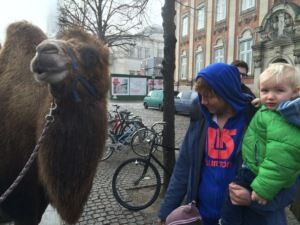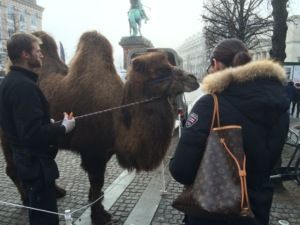News
Out and About: One hump or two with your milk?
This article is more than 9 years old.
Camelicious camel’s milk makes Copenhagen debut

If you don’t like it, you can hump it (photo: Andy Stiny)
I expected to see new and different sights when I arrived in Copenhagen, but when from a distance I saw two brown, furry lumps projecting from the middle of Højbro Plads on Saturday morning, I had to investigate.
A rare visitor
Turns out I was wrong. Those weren’t lumps, those were humps – as in two humps of real, live bactrian camel. The double humper is from northern Asia, unlike the much more common dromedary camel from the Middle East.
The bactrian variety “is considered to be a critically endangered species with less than 1,000 bactrian camels thought to be living in the wild parts of China and Mongolia”, according to the a-z-animals.com website.
So if they are so rare how did one end up munching carrots on a foggy day just off Copenhagen’s famed pedestrian shopping street, Strøget.
Turns out this camel – an object of extreme fascination among young and old with the requisite photo taking – was actually representing its brother camel in a promotion for the launch this week of Camelicious, a camel’s milk drink that uses lactose from the dromedary variety. Local cows beware.
Free taste of camel’s milk
Organisers at the event were dispensing free bottles of the stuff to curious passers-by with flavours including date, strawberry, chocolate, saffron and plain milk. This reporter sampled the date (very tasty) and strawberry flavours.
The milk is produced by the Emirates Industry for Camel Milk & Products (EICMP), a United Arab Emirates company established in 2003. Event organisers said the milk would be available starting Monday (February 29) in select shops. The company also produces cheese.
According to the company website, after the completion of its production facilities, Camelicious hit the shelves in the UAE in 2006 and was the first world-wide Camel milk company to have its product approved for distribution in the European Union with approval from the EU Commission in 2013. Camelicious products are currently exported to Kuwait, the United Kingdom, Jordan, Austria and Malaysia. The company started exports to the UK in 2014.
Its nutritious milk has 50 percent less fat that cow’s milk and “a high percentage of unsaturated fatty acids which … among other benefits, help reduce cholesterol to aid healthy cardiovascular functioning”, the company promises on its website.
A favourite of the Bedouin
Camel’s milk, which comes from the company’s 4,200-strong herd in the UAE, has traditionally provided proteins, carbohydrates and vitamins for the Bedouins who also use camel fat and milk to protect themselves from the harsh desert sun.
A small crowd of curious Copenhageners gathered around the camel at Højbro Plads to stoke its shaggy fur while the camel wrangler fed it carrots. Several assistants handed out small bottles of samples and answered questions.
The contents listed on the strawberry sample are: natural camel milk, fruit sugar, strawberry flavor and beet root juice concentrate for colour. I decided to have another look at the camel after my Saturday morning coffee and returned an hour later. No camel in sight. Was it a mirage?
For more information on the camel’s milk go to: camelicious.ae.











































